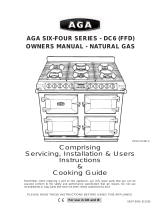CAUTION: THIS INSTALLATION MUST CONFORM WITH LOCAL CODES OR, IN THE
ABSENCE OF LOCAL CODES WITH THE NATIONAL FUEL GAS CODE, ANSI Z223.I/NFPA
54 AND NATIONAL ELECTRICAL CODE ANSI/NFPA 70 (IN CANADA CAN/CGA-B149) AND
ONLY USED IN A WELL VENTILATED SPACE, READ THESE INSTRUCTIONS BEFORE
INSTALLING OR USING THIS APPLIANCE.
PRIOR TO INSTALLATION, ENSURE THAT THE LOCAL DISTRIBUTION CONDITIONS
(NATURE OF GAS AND GAS PRESSURE) AND THE ADJUSTMENTS OF THE APPLIANCE
ARE COMPATIBLE.
THE GAS ADJUSTMENT CONDITIONS FOR THIS APPLIANCE ARE STATED ON THE DATA
PLATE WHICH IS SITUATED IN THE CENTRE VENT SLOT NEAR THE BASE OF THE
FRONT PLATE.
This appliance is not connected to a combustion products evacuation device. it shall be installed
and connected in accordance with current installation regulations. Particular attention shall be
given to the relevant requirements regarding ventilation.
It should be in accordance with any relevant requirements of the Gas Region and Local Authority.
The appliance must be disconnected from the gas supply piping system during any pressure
testing of that system test pressure in excess of 1/2 psi (3.5 kPa).
The appliance must be isolated from the gas supply piping system by closing its individual
manual shut off valve during any pressure testing of the gas supply system at test pressures
equal to or less than 1/2 psi (3.5 kPa).
On completion, test the gas installation for soundness and purge. Leak testing of the appliance
shall be conducted according to the manufacturer’s instructions.
NOTE: Use soapy water solution on new gas connections to ensure there are no gas leaks.
WARNING: ELECTRIC SHOCK HAZARD
It is the customers responsibility to contact a qualified electrical installer to make sure the
electrical installation is adequate and in conformance with National Electrical Code ANSI/FPA
70-latest edition, and all local codes and ordinances.
Take special care when cutting holes in walls or floor. Electrical wires may be behind the wall or
floor covering and could cause an electrical shock if you touch them.
Locate any electrical circuits that could be affected by the installation of this product and
disconnect power circuit.
Electrical ground is required on this appliance.
Do not have a fuse in the neutral or grounding circuit. A fuse in the neutral or grounding circuit
could result in electrical shock.
Do not use an extension cord with this appliance.
Check with a qualified electrician if you are not sure the appliance is properly grounded.
Failure to follow these instructions could result in death or serious injury.
INSTALLATION
5























